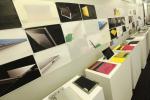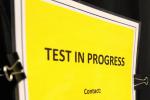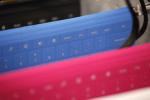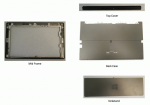
When it comes to designing new hardware, most companies are pretty quiet about the design process. Microsoft, with its Surface tablets, is taking a far more open approach than many other companies. Just a few days ahead of the launch of the Intel-powered Surface Pro, I got a chance to sit down with Ralf Groene, Microsoft’s Director of Industrial Design, earlier this week to talk about the history and the design process that eventually led to the Surface project as we know it today.
The German-born Groene brought a full case of Surface and Touch and Type Cover prototypes to the meeting. Sadly, Microsoft didn’t allow photography at this meeting, but the company provided us with a number of images that you can see throughout this post.
Even though Groene himself may not be a household name (yet), he worked on a number of products that you are probably familiar with. His first project out of college, while working at Palo Alto Design Group, was the Rocket eBook reader, one of the earliest e-readers. After that he worked for well-known design companies like Hartmut Essslinger’s Frog Design and then Ideo, where he became the design lead of the company’s Palo Alto studio. These experiences allowed him to work with lots of interesting clients as a consultant, but he didn’t get to work on the designs from the idea stage to product launch and was clearly itching to develop products from start to finish himself. Seven years ago, Microsoft hired Groene to start working on its mice and keyboards. He started out with the Arc Mouse, Arc Touch and Arc keyboard, as well as the LifeCam camera.
After a few years of doing that, Groene told me, Panos Panay called him into his office to talk about what would eventually become the Surface. “That was the birth of Surface,” Groene recalled. “We started out as a very small team with just a handful of people – really like a startup – and we were given a task: design computers for Microsoft.” At the time, of course, Microsoft didn’t build its own computers, “but it was an exhilarating thought” for him to work on this project. Who really came up with the idea of Microsoft doing its own computers isn’t actually clear, but it was obviously borne out of the company’s strategic outlook. Groene said that Steven Sinosfky, who has now left Microsoft, was their access point and gave them the task to begin working on the project. One thing Microsoft never used to figure out the design, though, was a focus group.
It didn’t take this core team of about 15 people all that long to come up with the early ideas for the Surface. One of the first decisions the team made was to do everything but the final assembly in-house, including engineering, software design, product design and manufacturing. Groene argues that a big company like Microsoft could have hired any consultant it wanted to, but “the actual value that you will create comes from the people who are actually committed to the business. We had zero consultants on this project.”
During the “startup phase,” the core team came up with most of the basic ideas for what the Surface should look like and what the brand should be about. Groene noted that some of the main ideas like the kickstand and click-on keyboard were developed very early on in the project. “It really contained all the elements that Surface and Surface Pro are now growing into.” Indeed, Groene showed me one of the earliest design prototypes that contained all the essential Surface elements and it already featured a keyboard as a cover and the kickstand. One interesting idea that was scratched very early on was to put a small screen on the back of the tablet to display status updates and other information. The team also looked at an 11.6 inch screen, but that just felt too big for a tablet, Groene said. Within 10 weeks or so, the team came up with the core ideas for Surface that essentially still remain the same today.
Every design, says Groene, needs to have a core message and a product needs to be built around this core idea. Design, in his view, is not about making things pretty. One thing the Surface team also realized early on was that the Surface should reflect the core values of what Microsoft stands for as a brand. “Microsoft is a big brand that carries a particular set of attributes. If you want to get things done, you use Word, Excel and you would find that Windows is actually something that is very useful,” Groene noted. Even as the PC is dissolving in front of our eyes and morphing into something else, those values still stand true, says Groene. That insight, he argues, was the main breakthrough that made the team decide on what has now become the Surface and Steven Sinofsky immediately bought into the idea, too.
This meant that the core mission of the Surface was, in Groene’s words “to bring Windows 8 to life.” Part of the inspiration for the final design was the fact that the Metro design in Windows 8 doesn’t feature a chrome. Just like Windows 8 gets out of the way and puts apps front and center, Groene believes that good design gets out of the way, too. He wants to build good tools and doesn’t care about fancy styling. Windows 8, he argued, is an “authentically digital” design. The old desktop, the one that’s essentially based on the Xerox desktop that Apple copied and Microsoft later adopted, too, was based in the analog world. “We lived in that ear for so long,” Groene said, “so when you come up with something new, it rocks people’s world a bit.”
Because Excel and Word are part of the Microsoft brand, the decision to add a keyboard in some form was pretty obvious, and having a functional cover just made sense to the team right from the outset. Groene noted, however, that one shouldn’t think of this Microsoft legacy as a “burden.” Instead, his team’s mission is to amplify these values and those of Windows 8 in general.
As for the interaction with the Windows 8 team itself while developing the Surface, Microsoft carefully argues that its team got the same access to early software builds as its other hardware partners. Given that the Surface project strained the relationship between Microsoft and some of its hardware partners a bit, that’s an argument I would expect Microsoft to make. What’s clear, though, is that the Windows 8 team played a role in what the Surface looked like, if only because Sinofsky was the team’s access point to the rest of the Microsoft hierarchy.
The Surface’s Touch Cover, of course, has long been a focal point of Microsoft’s marketing campaign for the Surface RT. In Groene’s view, the Touch Cover is obviously better than typing on glass, but he also believes it “pushes how you make keyboards forward.” The early prototypes, of course, were very primitive and nothing more than drawings on a piece of plastic. In our discussion, Groene likened the final design to the digital camera in that it turns something that was always analog into the digital world and makes it better. The team, of course, also tested lots of different magnets to ensure the cover would be able to hold the device and users would still be able to detach it without too much effort. Still, because Microsoft’s brand is about giving people choices (“We don’t dictate what people should like”), the company also decided to go ahead and make the Type Cover, as well.
While Microsoft has talked a lot about the Touch Cover, Groene also highlighted the design process behind the magnesium chassis that surrounds the Surface. For the Surface RT, the team’s resident material scientists developed a novel way to use hot, liquid magnesium that’s quickly pushed into a mold to create the device’s body and to ensure that it is light and sturdy at the same time.
When it comes to attention to detail, the body of the Surface is really where the design team got a workout. As Groene told me, he and Panay regularly went to Asia not just to work with the manufacturers, but also, with lots of gages and scales in tow, to measure every piece of the product to make sure it was up to spec. Groene estimates he flew to Asia at least 10 times last year. The team’s attention to detail went deeper than that, though. Groene, for example, noticed that the edge that surrounds the Surface was just a bit too sharp, so the team brought in new CNC machines to dampen this effect by adding a 3mm chamfer. While this came at some expense, the team had enough support from the top of the Microsoft hierarchy to do these kinds of things regularly. Similarly, the angle on the Surface Pro’s sides was supposed to remain the same as on the RT, but because it is thicker, that angle didn’t work without making the corners way too small. To solve this problem, Microsoft brought in expensive 5-axis milling machines to give the corners a different angle from the rest of the sides.
With the Surface Pro, Microsoft is about to expand its Surface family later this week by bringing the full power of Windows 8 to its own line of tablets. Because it uses an Intel chip, it is a bit thicker than the RT to allow for more vents and significantly larger batteries. While the Surface RT is made out of three pieces of the magnesium alloy, however (the frame, back and kickstand), the team improved its manufacturing methods just in time for the Pro model and can now build the frame and back as a single piece.
Early on, Groene noted, Microsoft decided that the Surface team was too small to tackle both the RT and Pro at the same time. He wasn’t quite sure why the RT became the first model they focused on. In his view, though, users should think of the two devices as siblings, not twins. The Pro is a laptop with tablet capabilities and the RT is a tablet that has laptop capabilities. The Pro is obviously more powerful than the RT, but in return, its battery doesn’t last as long and is heavier. Doing both, said Groene, sadly isn’t an option today. “You have to decide what you want: a truck or a speedster.” Both are useful in their own way, but if you try to combine both, you probably end up with an El Camino.
Looking ahead, Groene obviously couldn’t say much about the future of the Surface line beyond the Pro, but he did stress repeatedly that the RT and Pro are not endpoints – “we didn’t just stop having ideas.” Microsoft is obviously working on growing the Surface family. In what direction isn’t all that clear right now, but Groene said that he and his team “have a lot of passion around those ideas” and that we should expect a continuation of what we are currently seeing.
The core design team that worked on Surface is still very much intact and still very small. Chances are, Groene has a few more suitcases full of Surface 2 prototypes lying around somewhere in Microsoft’s Studio B and if the old adage that it always takes Microsoft three attempts to get a product right still holds, it’s definitely worth keeping a close eye on what this group will come up with next.








